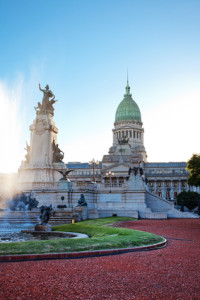Argentina, officially called the Republic of Argentine, has been populated since the Paleolithic period; Argentina is known to have the earliest recorded human presence in this area. Moving forward to the early 1500s, the Spanish began to colonize the area. This occurred in 1512.
 Geographically, it is the eighth largest country in the world, with the total land mass of 2,780,400 km2 or 1,073,500 sq mi. It is also the second largest in Latin America, the third largest populated area in South America, and the 33rd largest population overall in the world. These are some pretty impressive facts.
Geographically, it is the eighth largest country in the world, with the total land mass of 2,780,400 km2 or 1,073,500 sq mi. It is also the second largest in Latin America, the third largest populated area in South America, and the 33rd largest population overall in the world. These are some pretty impressive facts.
Argentina is located in southern South America and it shares borders with five other Latin America countries. They are Chile, Ecuador, Bolivia, Paraguay, and Uruguay along with South Atlantic Ocean. The country’s highest point is mount Aconcagua at 6,959m (22,831 ft) above sea level and the capital is Buenos Aries. Buenos Aries is the largest city in the country.
Argentina’s national flag is a tri-band, made up of three equal horizontal lines, light blue, white, and light blue. The flag with the sun emblem is called the Official Ceremonial Flag and the one without the sun is called the Ornamental Flag, which must always be flown under the Official flag.
The overall population has a colorful background with its roots tracing back to Italy, Spain, French and German populations. It also has populations that are mixed with a little Arab, Syria, Lebanese, Chinese, Korean and Japanese. The diversity in Argentina is much like the rest of world as we live in a very global and mobile society. Spanish is the primary spoken language; however, English is also taught in elementary schools with 42% of the population able to speak it. While the main religion of Argentina is Roman Catholic, it also houses the largest Muslim and Jewish communities in the Latin Americas.
The country’s rich literary history began in 1550, while the country’s music scene didn’t peak until the 1930’s with the coming of the Tango. Some of the most well known artists of this country come from various backgrounds in the arts. Those areas are Impressionism, Constructivism, Modernism and Fantasy art.
Gyula Kosice and other artists created the Madi Movment which quickly spread to North America and Europe. The oldest known work(s) of art can be found in the Cave of Hands dating back from 13,000-9,000 years. So in addition to Argentina having a diverse population and a rich sense of the arts, they also lay claim to some of the oldest known relics in the world.
The food scene is just as diverse as its population. These include foods such as deserts, pasta, and sausage dishes, which are also common to Europe. In addition, there are also Criollo creations, and the world famous empanadas. Argentina is known to have the highest consumption of red meat in the world. These include the Asado Argentine Barbecue with sweetbreads, blood sausages, and chorizo. The deserts can range from a Vinnese style pasty called Facturas, which is a dulce de leche, sort of a milk carmel dish. Adding to the fabulous food menus, are the Argentine wines. Some of these wines fall into the world’s finest class such as Malbec, Chardonnay, and Syrah. As you can see, everything from this country’s cuisine, art, history, and culture are just as colorful as the people that inhabit this beautiful and diverse country.




